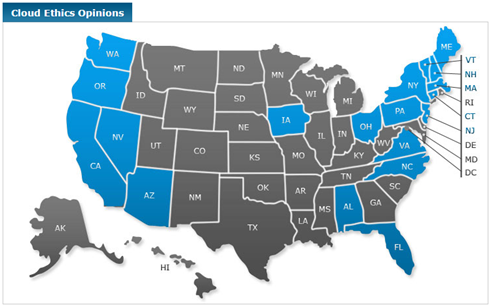This is the eighth (and final) of the 2015 LegalTech New York (LTNY) Thought Leader Interview series. eDiscovery Daily interviewed several thought leaders at LTNY this year and generally asked each of them most of the following questions:
- What are your general observations about LTNY this year and how it fits into emerging trends? Do you think American Lawyer Media (ALM) should consider moving LTNY to a different time of year to minimize travel disruptions due to weather?
- After our discussion last year regarding the new amendments to discovery provisions of the Federal Rules of Civil Procedure, additional changes were made to Rule 37(e). Do you see those changes as being positive and do you see the new amendments passing through Congress this year?
- Last year, most thought leaders agreed that, despite numerous resources in the industry, most attorneys still don’t know a lot about eDiscovery. Do you think anything has been done in the past year to improve the situation?
- What are you working on that you’d like our readers to know about?
Today’s thought leader is Craig Ball. A frequent court appointed special master in electronic evidence, Craig is a prolific contributor to continuing legal and professional education programs throughout the United States, having delivered over 1,500 presentations and papers. Craig’s articles on forensic technology and electronic discovery frequently appear in the national media, and he currentlyblogs on those topics at ballinyourcourt.com.
What are your general observations about LTNY this year and how it fits into emerging trends? Do you think American Lawyer Media (ALM) should consider moving LTNY to a different time of year to minimize travel disruptions due to weather?
My impression is that the crowd is down. I’m not sure whether that was the challenging travel conditions (many people, daunted by winter storms and flight diversions, may have headed home), but looking at today’s keynote address, it wasn’t a full house. Still, it was a quality house. Fewer browsers isn’t bad for the exhibitors when the quality of leads improve. The folks that come to grab tchotchkes aren’t necessarily the folk vendors want to engage.
This is the first time in quite some time that I was able to peruse 100% of the exhibitors’ booths. That ALM wasn’t using the top floor this year suggests that, the number of exhibitors must be down, too. I’d attribute that to marketplace consolidation and to the ranks of vendors who’ve decamped to other venues, believing they can glean the benefits of being at LegalTech without exhibiting. I find myself in meetings at the Warwick Hotel as often as at the Hilton.
LegalTech has grown more important through the disappearance of other venues of this scale and breadth. LTNY dominates as the one place where you see everybody and everything in the marketplace. But, that’s a cyclic phenomenon and competition will return. ILTA has grown in scale and import, and it serves as an influential alternative venue for kicking tires. It’s probably as important to be at ILTA as it is to be here in New York. The West Coast LegalTech has lost steam, but should be energized by its move to the Bay Area. The biggest challenger to these big tent events is improved communication tools. Screen sharing has made it as easy to be at your desk and see a high quality demo as fight the crowd.
There was also a different vibe, a “changing of the guard” feel. Underscoring the late Browning Marean’s absence, the temporary shuttering of the Hilton lobby bar was metaphorical, as was Monica Bay’s retirement. It signals the handing over of the reins to a new generation of disruptive competitors, and of established players seeking to reinvent and present themselves in fresh ways. That’s exciting. I’ve attended LegalTech since the latest technology was fire (we called it “Environmental Governance”), and I’m seeing many new faces, people I don’t recognize when I scan the cocktail lounge. That’s renewal: positive, but bittersweet.
As for the educational sessions, I’m biased as a member of the educational advisory board that plans the curriculum; but, the sessions I attended were first rate. The presenters did their homework; panelists weren’t “winging it.” The content was substantive and engaging. Has electronic discovery eaten the show? Sure, but many other offerings are here. They just don’t sponsor as many educational tracks, buy the big booths or host the prominent events. I know that some lament the extent to which electronic discovery has taken over; but, that’s a function of demand. Content follows the money.
Having said that, I feel that there’s a sense of ennui that pervades the industry. Many are tired of eDiscovery, manifested as efforts to shift the conversation to other things. When I plan eDiscovery programs, there’s a push to bring in privacy and cybersecurity or blow the topic up into information governance. All of those are valuable; but, they aren’t the core curriculum of eDiscovery, and we haven’t yet mastered the fundamentals of electronic discovery. Those hot topics serve to displace education still needed and topics more central to electronic discovery. We are still laying the foundation.
Trend-wise,we’re always a bit late to the party in eDiscovery. We aren’t doing enough to acknowledge that, like Elvis, much of the information we must address in discovery has left the building. It’s gone mobile, and we lack the scalable processes and tools to effectively and efficiently preserve and process mobile data. I’m hoping that the things I’m saying to vendors (and that I hope others are saying as well) will get them to look toward the hill, or even over it. Mobile and cloud are not “coming.” They’re here in a big way, and they’re not going away or becoming less important.
Finally, if it were my call, I’d swap the dates for the east and west events, giving three years notice. But, a wintry convention probably costs much less, so fuggedaboudit.
After our discussion last year regarding the new amendments to discovery provisions of the Federal Rules of Civil Procedure, additional changes were made to Rule 37(e). Do you see those changes as being positive and do you see the new amendments passing through Congress this year?
I am comfortable with the end result and think there is a virtual certainty that the amendments will sail through Congress with no more than a tweak or two, becoming our rules in December. With respect to their impact on preservation (which was the principal impetus behind the efforts to change the rules), it will make absolutely no difference. I’ve been asking people what they will not retain or do once the amendments take hold that they weren’t saving or doing before, and I’ve not had a single person articulate the savings they expect to realize on the strength of Rule 37(e). That said, I think 37(e) significantly immunizes negligent spoliation from significant sanctions. If there was going to be a 37(e)–and the millions spent by businesses lobbying for same sealed that deal–then Judge Grimm and others crafted the best 37(e) we could hope for.
Last year, most thought leaders agreed that, despite numerous resources in the industry, most attorneys still don’t know a lot about eDiscovery. Do you think anything has been done in the past year to improve the situation?
I don’t think enough are struggling with it. I think many have simply chosen to move on, whether they get it or not. They’re tired of eDiscovery, and they’re changing the conversation. That was my point earlier about, “Oh, you want to have an eDiscovery conference? Talk about cybersecurity or privacy instead.” They hate having to deal with the nitty-gritty of eDiscovery competency, like preservation and forms for production. Most still view “legal hold” as a document instead of a process. On the other hand, much of eDiscovery has been enshrined as a repeatable process. It may be a lousy process, but look how well it replicates! That’s a bit cynical. I do see incremental improvement and I see it in a variety of areas.
Those managing discovery in their organizations have gotten savvier and more refined in their thinking. Many organizations are in capable hands. Others have gotten what they wanted, but not what they need. By that I mean they acquired buzzwords, a few rules of thumb and a checklists to trot out without much understanding of what they are doing.
As much as I criticize lawyers for their intransigence in seeking out information about electronic discovery and refusing to master the barest fundamentals of information technology, as a profession, we have done a poor job of making materials available that are engaging and accessible. Even those lawyers willing to put effort into learning don’t know where to go for “eDiscovery 101, let alone 201 and 301.” Where are the primers and training tools? Other education supplies a pattern, a path for learning that we know how to follow. But, for electronic discovery, we’ve never had that path set before us. We’re starting to build curriculums in electronic discovery in a variety of law schools and more law schools are offering electronic discovery courses. Some of which are quite impressive and some of which are rather ministerial and give short shrift to the all-important “e” that makes eDiscovery different.
But, I’m encouraged that the coming year and the year after are going to be threshold intervals for leaps forward that we can take some pride in with regard to generating educational resources. Things are happening. Judge John Facciola’s retirement also fuels that “end of an era”, “handing over the reins” sense I mentioned; but it frees Judge Facciola’s up to concentrate more on teaching and leadership. I’m encouraged by that, and I look forward to working with him and following him in a variety of endeavors.
What are you working on that you’d like our readers to know about?
The coming year, I hope to focus on pulling together a group of educators to develop a core curriculum for electronic discovery – at the law school level, a curriculum that can be taught by those whose strength is the law and one that can be taught by those whose strength extend into the technology. I see a need to rethink professional development. We keep repeating in CLE much of the same stuff over and over again. We need to educate lawyers and litigation support, paralegals, legal assistants, IT – the people “in the trenches” – opening a path to meaningful skills and accreditation (not just a certificate and some letters to stick after one’s name). We need to offer the means to acquire genuine expertise and competence. So, I will concentrate on working with others to develop materials that can be freely circulated to law students and used by law professors, such as distilled case law, discussion questions, workbooks, tools, hands-on exercises and all the rest that serve to help schools offer practical skills courses and new lawyers gain talents that make them more valuable to firms and clients.
As I look around, I’m impressed at how much difference an individual can make in this young field. People like Richard Braman, Browning Marean, George Socha, Bill Hamilton, Tom Allman, Ariana Tadler, the rock star eDiscovery judges and others inspire me to keep on the oars and beat on, boats against the current, and unlike Gatsby, bearing ceaselessly toward tomorrow.
Thanks, Craig, for participating in the interview!
And to the readers, as always, please share any comments you might have or if you’d like to know more about a particular topic!
Disclaimer: The views represented herein are exclusively the views of the author, and do not necessarily represent the views held by CloudNine. eDiscovery Daily is made available by CloudNine solely for educational purposes to provide general information about general eDiscovery principles and not to provide specific legal advice applicable to any particular circumstance. eDiscoveryDaily should not be used as a substitute for competent legal advice from a lawyer you have retained and who has agreed to represent you.









